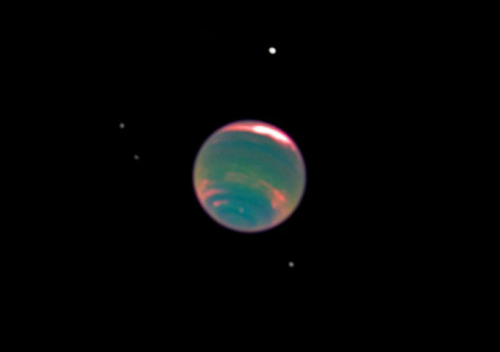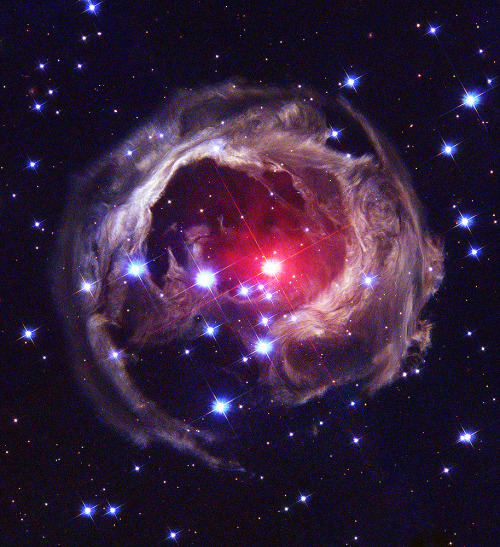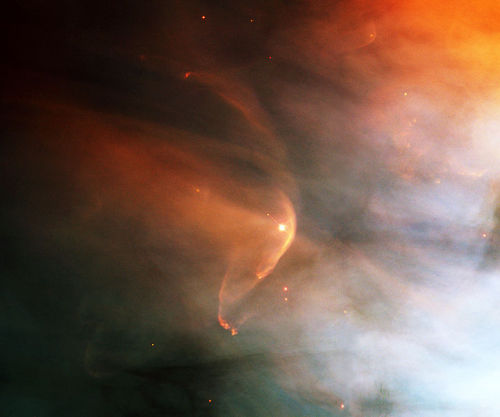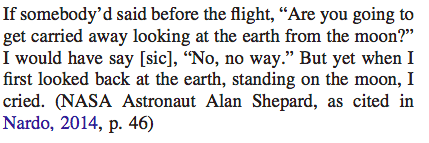View Of Neptune In The Infrared, Showing Bands Of Methane In Its Atmosphere Captured By The Hubble Space

View of Neptune in the infrared, showing bands of methane in its atmosphere captured by the Hubble Space Telescope, this image is surrounded by four of its satellites, Proteus, Larissa, Despina and Galatea.
Credit: NASA/ESA/Hubble
More Posts from Xnzda and Others

The moon occluding the sun during an eclipse. The fine threads you can see are part of the solar corona, and actually titanic spools of ultra-hot plasma, curling and bending with the sun’s complex magnetic field.

Aurora and Manicouagan Crater from the Space Station : How many of these can you find in today’s featured photograph: an aurora, airglow, one of the oldest impact craters on the Earth, snow and ice, stars, city lights, and part of the International Space Station? Most of these can be identified by their distinctive colors. The aurora here appears green at the bottom, red at the top, and is visible across the left of image. Airglow appears orange and can be seen hovering over the curve of the Earth. The circular Manicouagan Crater in Canada, about 100 kilometers across and 200 million years old, is visible toward the lower right and is covered in white snow and ice. Stars, light in color, dot the dark background of space. City lights appear a bright yellow and dot the landscape. Finally, across the top, part of the International Space Station (ISS) appears mostly tan. The featured image was taken from the ISS in 2012. via NASA

Light Echoes from V838 Mon
For reasons unknown, star V838 Mon’s outer surface suddenly greatly expanded with the result that it became the brightest star in the entire Milky Way Galaxy in January 2002. Then, just as suddenly, it faded. A stellar flash like this has never been seen before.
It’s true that supernovae and novae expel matter out into space. But while the V838 Mon flash appears to expel material into space, what is seen here is actually an outwardly moving light echo of the bright flash. In a light echo, light from the flash is reflected by successively more distant rings in the ambient interstellar dust that already surrounded the star.
V838 Mon lies about 20,000 light years away toward the constellation of Monoceros the unicorn. In this Hubble Space Telescope image from February 2004, the light echo is about six light years in diameter.
Image Credit: NASA, APOD, ESA, H. E. Bond (STScI)
Stellar Winds
Stellar winds are fast moving flows of material (protons, electrons and atoms of heavier metals) that are ejected from stars. These winds are characterised by a continuous outflow of material moving at speeds anywhere between 20 and 2,000 km/s.

In the case of the Sun, the wind ‘blows’ at a speed of 200 to 300 km/s from quiet regions, and 700 km/s from coronal holes and active regions.

The causes, ejection rates and speeds of stellar winds vary with the mass of the star. In relatively cool, low-mass stars such as the Sun, the wind is caused by the extremely high temperature (millions of degrees Kelvin) of the corona.

his high temperature is thought to be the result of interactions between magnetic fields at the star’s surface, and gives the coronal gas sufficient energy to escape the gravitational attraction of the star as a wind. Stars of this type eject only a tiny fraction of their mass per year as a stellar wind (for example, only 1 part in 1014 of the Sun’s mass is ejected in this way each year), but this still represents losses of millions of tonnes of material each second. Even over their entire lifetime, stars like our Sun lose only a tiny fraction of 1% of their mass through stellar winds.

In contrast, hot, massive stars can produce stellar winds a billion times stronger than those of low-mass stars. Over their short lifetimes, they can eject many solar masses (perhaps up to 50% of their initial mass) of material in the form of 2,000 km/sec winds.

These stellar winds are driven directly by the radiation pressure from photons escaping the star. In some cases, high-mass stars can eject virtually all of their outer envelopes in winds. The result is a Wolf-Rayet star.

Stellar winds play an important part in the chemical evolution of the Universe, as they carry dust and metals back into the interstellar medium where they will be incorporated into the next generation of stars.
source (read more) + Wolf–Rayet star

NASA’s Most Shocking Image
This image is a 1.5… *BILLION* pixel photograph of the Andromeda Galaxy.
To view the image in all its glory go here.
NASA is the coolest thing that’s ever happened.

The Spanish Dancer and her supernova by strongmanmike2002 on Flickr.


Astronauts talking about viewing the earth from the moon, from The Overview Effect: Awe and Self-Transcendent Experience in Space Flight
-
 nair-bento96 reblogged this · 2 weeks ago
nair-bento96 reblogged this · 2 weeks ago -
 iwannarunaway-13 liked this · 2 weeks ago
iwannarunaway-13 liked this · 2 weeks ago -
 mcsnauff liked this · 2 weeks ago
mcsnauff liked this · 2 weeks ago -
 lesbianfeydrautha liked this · 2 weeks ago
lesbianfeydrautha liked this · 2 weeks ago -
 ppeachicetea reblogged this · 2 weeks ago
ppeachicetea reblogged this · 2 weeks ago -
 goldcrumble reblogged this · 2 weeks ago
goldcrumble reblogged this · 2 weeks ago -
 robinniko reblogged this · 2 weeks ago
robinniko reblogged this · 2 weeks ago -
 unsuredefleur liked this · 3 weeks ago
unsuredefleur liked this · 3 weeks ago -
 quartzmilk reblogged this · 3 weeks ago
quartzmilk reblogged this · 3 weeks ago -
 miss-charito liked this · 4 weeks ago
miss-charito liked this · 4 weeks ago -
 1942pndr liked this · 2 months ago
1942pndr liked this · 2 months ago -
 robinniko liked this · 2 months ago
robinniko liked this · 2 months ago -
 franciscamm liked this · 2 months ago
franciscamm liked this · 2 months ago -
 jandara946 liked this · 2 months ago
jandara946 liked this · 2 months ago -
 sunsetviolent25 liked this · 3 months ago
sunsetviolent25 liked this · 3 months ago -
 lucielives reblogged this · 3 months ago
lucielives reblogged this · 3 months ago -
 imageness-retro reblogged this · 3 months ago
imageness-retro reblogged this · 3 months ago -
 imageness-retro liked this · 3 months ago
imageness-retro liked this · 3 months ago -
 wavywavy reblogged this · 3 months ago
wavywavy reblogged this · 3 months ago -
 kurbagalandin reblogged this · 3 months ago
kurbagalandin reblogged this · 3 months ago -
 kurbagalandin liked this · 3 months ago
kurbagalandin liked this · 3 months ago -
 westdayever reblogged this · 3 months ago
westdayever reblogged this · 3 months ago -
 i-iii-iii-vii liked this · 3 months ago
i-iii-iii-vii liked this · 3 months ago -
 cargojorts reblogged this · 4 months ago
cargojorts reblogged this · 4 months ago -
 cliriqstars reblogged this · 4 months ago
cliriqstars reblogged this · 4 months ago -
 sunflarie liked this · 4 months ago
sunflarie liked this · 4 months ago -
 empirewithoutend reblogged this · 4 months ago
empirewithoutend reblogged this · 4 months ago -
 empirewithoutend liked this · 4 months ago
empirewithoutend liked this · 4 months ago -
 thenovaconvention reblogged this · 5 months ago
thenovaconvention reblogged this · 5 months ago -
 kreadstornham liked this · 5 months ago
kreadstornham liked this · 5 months ago -
 ashestoshadows reblogged this · 5 months ago
ashestoshadows reblogged this · 5 months ago -
 xxviisworld liked this · 6 months ago
xxviisworld liked this · 6 months ago -
 smutny-kotek reblogged this · 7 months ago
smutny-kotek reblogged this · 7 months ago -
 veggiesforthelionking reblogged this · 7 months ago
veggiesforthelionking reblogged this · 7 months ago -
 sadgirlzclubxo reblogged this · 7 months ago
sadgirlzclubxo reblogged this · 7 months ago -
 omgherbalicious reblogged this · 7 months ago
omgherbalicious reblogged this · 7 months ago -
 omgherbalicious liked this · 7 months ago
omgherbalicious liked this · 7 months ago -
 shadowyfigure1207 liked this · 7 months ago
shadowyfigure1207 liked this · 7 months ago -
 makeovtparadise liked this · 7 months ago
makeovtparadise liked this · 7 months ago -
 cosmicrae liked this · 7 months ago
cosmicrae liked this · 7 months ago -
 moonlitdreams98 liked this · 7 months ago
moonlitdreams98 liked this · 7 months ago -
 09-30-19 reblogged this · 8 months ago
09-30-19 reblogged this · 8 months ago -
 09-30-19 liked this · 8 months ago
09-30-19 liked this · 8 months ago -
 chryso-poeia liked this · 8 months ago
chryso-poeia liked this · 8 months ago
![Swirls And Colors On Jupiter From Juno [3709x2772]](https://64.media.tumblr.com/a02cf38823ae6cfdd3b32a401035a7a3/tumblr_pij9hl3nnd1rcl722o1_500.jpg)

